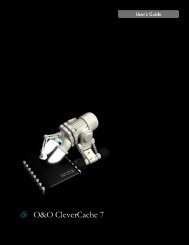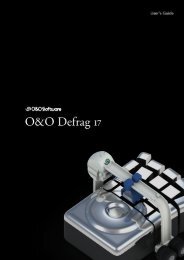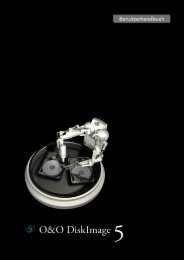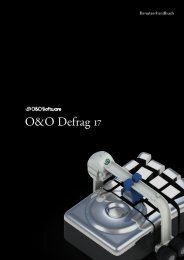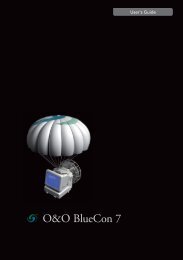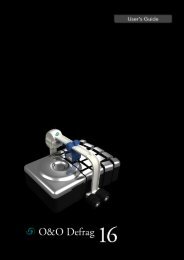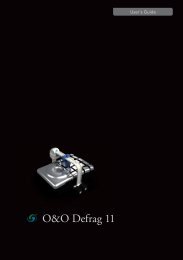O&O DiskImage 7 User's Guide - O&O Software
O&O DiskImage 7 User's Guide - O&O Software
O&O DiskImage 7 User's Guide - O&O Software
Create successful ePaper yourself
Turn your PDF publications into a flip-book with our unique Google optimized e-Paper software.
About O&O <strong>DiskImage</strong> 7<br />
Additional properties of the Workstation and Server Editions<br />
You can run the following network functions when using O&O <strong>DiskImage</strong> Workstation and Server Editions in conjunction<br />
with O&O Enterprise Management Console:<br />
• Images of the entire business network<br />
• Manage your computers in sites<br />
• Define settings for sites<br />
• Plan a schedule for the automatic imaging of computers or sites across a network, with just a few clicks of the<br />
mouse<br />
• Automatic remote installation of O&O <strong>DiskImage</strong> on network computers<br />
• Execute Windows commands (batches) before and after the running of a job across a network<br />
The O&O Enterprise Management Console is included in delivery if you have purchased licenses as part of the O&O<br />
EasyLicensing volume license program. We will happily advise you on applying O&O Enterprise Management Console<br />
in your company.<br />
E-Mail: sales@oo-software.com<br />
General Terms and Definitions<br />
To simplify working with O&O <strong>DiskImage</strong>, certain terms will be explained in the following chapters:<br />
Drive/Partition<br />
A drive is a reserved area of the hard disk. Multiple drives can be found on a hard disk. In the following text, the term<br />
“drive” will be used to depict (single) partitions as well as logical drives in extended partitions and volumes.<br />
Drives are used, for example, to separate documents from programs. A division in two partitions has become generally<br />
accepted:<br />
• Drive C: for operating systems and programs<br />
• Drive D: for documents, e.g. photos, Office documents, music, etc.<br />
This, for example, makes it easier to separate data and system images with O&O <strong>DiskImage</strong>.<br />
Image<br />
An image is a "mirror" of your drive (partitions). This “copy” contains all information taken from the original. A special<br />
feature of an image is that the file format is specially compressed and takes up much less disk space than the original.<br />
The more often you create images of your drive, the less you need worry about data loss. Should data on the original<br />
drive be lost or damaged, you can restore your last image with all its data onto your computer. With just a few mouse<br />
clicks, you can recover the original status of your drive before the last imaging.<br />
An image can be made up of multiple image files (*omg). For example if one disk is not sufficient to store the image and<br />
more are needed, e.g. CD/DVDs.<br />
The term image is also used in a wide sense for file backups.<br />
Difference File backup and Drive image<br />
Files are backuped directly in the form of data. This type of image includes only file information, no drive information is<br />
imaged. The file format is OBK (*.obk).<br />
A drive image stores all used or all sectors of a drive. This automatically also creates an image of the file system and<br />
all files and folders. The file format is OMG (*.omg).<br />
O&O <strong>DiskImage</strong>-2



